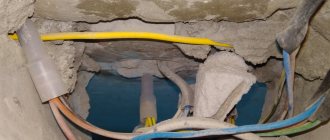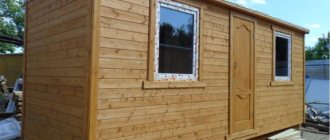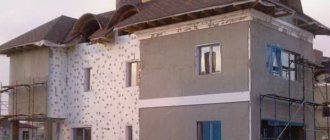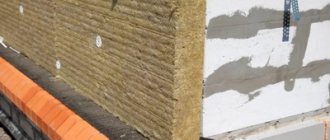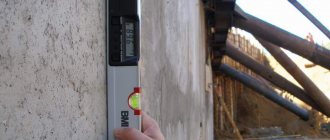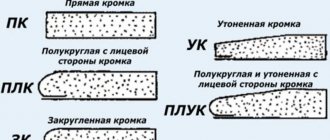Old panel houses especially need insulation. This becomes noticeable with the onset of cold weather, when the heating system cannot cope with its tasks. Today there are many ways to carry out such work, for example, insulating the walls of a panel house from the inside. This technology is relevant if external thermal insulation is impossible due to the fact that the facade of the building is not allowed to be touched.
Features of insulating a cold wall from the inside
The cold penetrates from the outside through the seams in panel houses. If it is not possible to fill them due to certain circumstances, insulation should be carried out from the inside. For this you can use polystyrene foam or mineral wool. These materials are supplemented with foil insulation or insulation paint is used separately. Typically, the work involves installing a frame, inside which additional insulating layers are laid, covered with plasterboard on top.
If you plan to load the walls with something heavy, then you can apply plaster over the insulation, saving money. When there is no desire to install drywall, you can plaster with polystyrene foam, as well as mineral wool. In the latter case, the material must have a high density. If you want to prefer mineral wool for insulating a panel house from the inside, then it is better to choose its basalt variety, which is also called stone. This material is good because it is not afraid of moisture and tolerates heat well. In this case, it is possible to exclude the use of a membrane, which, during external thermal insulation, acts as a vapor and water barrier.
Flaws
However, insulating a concrete wall from the inside of a building is not without its drawbacks, and quite noticeable ones at that:
- As a result of covering a room with insulating material, the walls increase in thickness, and, as a result, the area of the room itself decreases.
- Another disadvantage of internal thermal insulation is the deterioration of the climate in the room. This occurs due to the fact that part of the wall, which has a high ability to accumulate heat, after internal insulation ends up in a zone with low temperature.
Note! A prerequisite for the effective implementation of thermal insulation work is compliance with the physical characteristics of heat and moisture transfer.
- The outer wall of a building behind a layer of internal insulation significantly loses its heat-saving properties. As a result of this, as well as the large gap in partial pressure units inside and outside the building, condensation occurs behind the insulation layer in winter.
Correct fastening
Under such conditions, the walls begin to become damp, which does not stop even in the summer, and become covered with a layer of fungi, the presence of which indicates violations of the sanitary and hygienic standards of the living space.
- Another disadvantage is the formation of a number of thermal bridges along the perimeter of the building frame due to the rigid connection of partitions and ceilings with the load-bearing wall, as well as due to the absence of cut-off thermal insulation liners between them.
Types of insulation
When insulating the walls inside an apartment in a panel house, you can use one of many modern solutions. In addition to the above options, it can be polystyrene foam, which is much easier to work with. But it is important to consider that polystyrene foam does not allow steam to pass through, which means that over time dampness will form underneath it, which will cause the formation of fungus and mold.
If you don’t want the walls of the apartment to move inward too much, you can choose warm plaster for interior work, but the effect from it will be much less than from foam materials. You can also choose modern liquid ceramics. Just a 1 mm layer will be enough to equate it to 5 cm of mineral wool. Liquid ceramics consists of bubbles filled with air.
If a store offers you foil insulation, and the seller claims that it can be used as a stand-alone material, you can be sure that this is not the case. The effect of such a layer, of course, will be, but not as significant as they want to imagine it.
Minvata
When insulating the walls of a panel house from the inside, you can use mineral wool. But experts advise using it in extreme cases, because it needs to be protected for at least two reasons. The first is that if particles have free access to a room, they can harm human health. The second is expressed in the fact that mineral wool becomes saturated with moisture, settles and loses its original properties. Even if you cover the insulation layer with film on both sides, water will still penetrate into it, which over time will negate all efforts at thermal insulation. But if you still want to install it, then you will need to install the frame and insert the end parts of the material into profiles.
Expanded polystyrene insulation
If you want to do the thermal insulation yourself, you can use polystyrene foam. It can be installed with glue, additionally reinforced with dowels. A fiberglass mesh is applied on top, which is embedded in the plaster. With such insulation of the walls of a panel house from the inside, you need to additionally consider the ventilation system, since the created layer will have low vapor permeability.
Before installing insulation, you need to remove all old finishes from the walls, including wallpaper. Damage is repaired with putty. Next, the surface can be covered with soil. An acrylic-based composition is perfect. It would be better if it had antifungal properties. Before installing the insulation, waterproofing should be laid on the wall. You can use plastic film for this. Insulation is installed on top; you need to start working from below, installing the slabs in a checkerboard pattern.
As soon as the adhesive composition has dried completely, which will happen in about 2 days, you can make holes in the insulation, of which there should be 6 pieces for each sheet. Dowels will be inserted there, which will further increase the strength of the structure. The end seams should be filled with pieces of insulation. At the next stage, a reinforced mesh is applied, which is embedded in the liquid finishing layer. Putty should be applied on top, which is covered with wallpaper or other decorative material.
Extruded polystyrene foam
Insulation of the walls of a panel house from the inside is often carried out with an extruded type of polystyrene foam. The work is carried out according to the same algorithm as described above. This material can be selected taking into account the density, which reaches 47 kg/m3. This indicator affects the strength of the material, but in indoor conditions this is not very important. The formed layer will be flammable, so it must be well protected from ignition. For more convenient installation, you should choose products with recesses on the edges. It ensures a tight fit of the plates to each other.
Use of polystyrene foam
When insulating the walls of a panel house from the inside, foam is rarely used, since its effect on health has not been proven. If it is necessary to carry out work in the ceiling area, it is better to mount it from the attic side. When purchasing this material, it is important to exclude the artisanal production method by requesting a certificate confirming the quality.
Application of keramoizol
If you want to insulate your walls yourself, you should consider liquid thermal insulation, which is made on the basis of polymer resins. Among the ingredients there are mineral fillers that look like balls. They provide reflection of thermal energy. When applied, polymerization of the composition and balls occurs, which makes it possible to obtain an imitation of a thermos.
This material allows not only to insulate walls, but also to make them more protected from the penetration of extraneous noise. This relatively new material is sold in containers of different sizes. It is characterized by the qualities of steam and water resistance, as well as durability. Installation consists of forming several layers. To achieve the best effect, you need to apply 6 layers. The direction of movement of the brush should be perpendicular between approaches. The only disadvantage of this solution is the high cost.
Penoizol insulation
Insulation of the walls of a panel house from the inside is sometimes carried out with foam insulation. It is a liquid version of foam that is manufactured directly on the construction site and poured into hollow structures or formwork. In this case we are talking about carbamide foam, which is quite difficult to use in domestic conditions.
The work is inexpensive, the result is practical, and the manipulation time is reduced. Penoizol has a low density, is ready to last for a long time and is characterized by low thermal conductivity. The layer is not dangerous in the event of a fire; the material has environmentally friendly qualities and cannot create suitable conditions for the emergence of biological life.
Using Asstratek
For internal insulation of a panel house, Astratek, which is a liquid thermal insulation, can be used. The structure of the material is microporous. Using it, you can form a seamless coating that significantly reduces heat loss without creating additional loads on walls and ceilings.
With such insulation of a panel house from the inside, you can be sure that the material can be used under different temperature conditions, as well as on different objects. The material adheres well to the surface, eliminates corrosion, and contains organic solvents among the ingredients.
Is it possible to insulate with outdoor materials?
Materials that are intended for external work cannot be used for internal thermal insulation; they can pose a danger to the health of people and animals.
When exposed to temperature, they release toxic substances that accumulate in the human body and cause chronic diseases. For example, while in a room insulated with foam plastic, people began to experience headaches and cramps.
In addition, some materials for outdoor work are flammable.
Installing insulation on brick walls
Before starting work, it is important to decide what material will act as insulation. It is important to begin with to weigh all the pros and cons and understand that condensation will form during internal insulation in any case. If you nevertheless decide to install foam plastic or any other material from the side of the room, you must attach a vapor barrier material to the wall that will extend to the ceiling and floor. The seams are taped and should be laid overlapping each other.
Now you can install the sheathing, the step between the elements of which should be less than the width of the thermal insulation used, if it is elastic. The depth of the frame must correspond to the thickness of the insulation. Thermal insulation slabs are laid out in cells, covered with a vapor barrier, and the seams are sealed. The next layer will be a counter-lattice, which is sheathed with chipboard or any other sheet material. This work is necessary to ensure that the materials inside are as well ventilated as possible.
Advantages
Sometimes insulating concrete walls from the inside is the only way to eliminate the problem of cold walls.
This happens for a number of specific reasons:
- The first reason is that not all rooms can be thermally insulated from the outside.
- The second reason is the possibility of thermal insulation of internal walls at any time of the year and at any external air temperature, as well as the absence of the need for finishing work, in contrast to the technology of thermal insulation work on the outside of the house.
- And the last advantage of internal insulation over external insulation is the preservation of the appearance of the structure in its original state, which is important when carrying out work with complex historically valuable building facades.
Insulation of walls using the electric floor method
If you decide to abandon the installation of extruded polystyrene foam, replacing this method with wall insulation using the electric floor method, you must weigh all the positive and negative aspects of this technology. Experts say that good heat transfer cannot be achieved. The heating components will be located in the wall, and the heat will have to work its way through the trim or drywall. In this case, the space only a few tens of centimeters from the wall will warm up, while the heated air will immediately begin to rise upward. The result will be the need to install an additional electric heating device, which will entail costs.
If wallpaper and decorative tiles are pasted on the walls as a finishing touch, you may encounter the fact that the materials will move away from the surface under constant heating. With such a heating arrangement, it will not be possible to place furniture or electrical equipment against the wall, as they will quickly fail and, in addition, will block the air flow.
Having installed such a heating system, you will be faced with impressive heat losses, because energy will go not only inside the room, but also outside the house. Foil thermal insulation is placed under the infrared fabric (to prevent such phenomena), but this only aggravates the situation, and heating is even reduced. Such walls, where the electrical cable is laid, can no longer be used for hanging equipment and furniture. The same condensation will form between the warm and cold surfaces of the wall, which cannot but become a serious obstacle to installing such a heating system.
Heat insulator thickness
Difference between materials according to thermal conductivity characteristics relative to brickwork
Calculation of the required thickness of insulation is carried out by multiplying its thermal conductivity coefficient by the regional indicator. So for Moscow the optimal choice is the following numbers:
- mineral wool - 150 mm;
- polyurethane foam - 100 mm;
- polystyrene foam - 100 mm;
- expanded polystyrene - 100 mm;
- penoplex - 100 mm.
When finishing houses, you can combine heat insulators, applying them to the features of the architecture and wall materials.
Facade finishing
After the insulation of the apartment from the outside is completed, it is necessary to cover the insulation with a layer of decorative material. This can be plaster, ventilated facade, siding and other similar types of finishing.
If the work is carried out correctly, then within a few hours the temperature in the apartment will rise by 1-2 degrees, and after a day it will reach normal.
When preparing to carry out floor insulation work, you should not forget about ventilation. If you do not provide air flow and steam outflow into the apartment, the room will become stuffy, damp, mold will appear, and it will be unpleasant to be inside.
Dew point: physics of the phenomenon
The ratio of humidity and temperature at which steam turns into droplets is called the dew point. Under natural conditions, this is how fog, dew, frost and clouds are formed.
If the water vapor is at the dew point, it is called saturated. The amount of steam at which it becomes saturated depends on the temperature: the colder it is, the less steam is required. To indicate how close steam is to the dew point for a given temperature, relative humidity is used, which is expressed as a percentage. 100% is saturated vapor that is ready to fall out as mist or dew.
In construction, the dew point is not a point on a temperature scale, but rather the area where water vapor can become saturated. This point should always be outside the wall on the street side. To achieve this effect in winter, you need to carefully calculate the vapor permeability and thermal conductivity of surfaces. In any weather, the outer wall of the building must be warmer than the surrounding air so that the steam evaporates from its surface and has time to dissipate before it falls in the form of frost. It should be taken into account that in cold weather the dew point approaches the wall, and in warm weather it moves away.
If the temperature difference between the wall and the air outside is insufficient, the dew point moves closer to the wall or inside it. Moisture condenses on the surface or between layers of material where cold and warm air come into contact. This leads to negative consequences, which include:
- In the destruction of materials;
- Freezing of the wall in frost;
- The appearance of mold and mildew.
